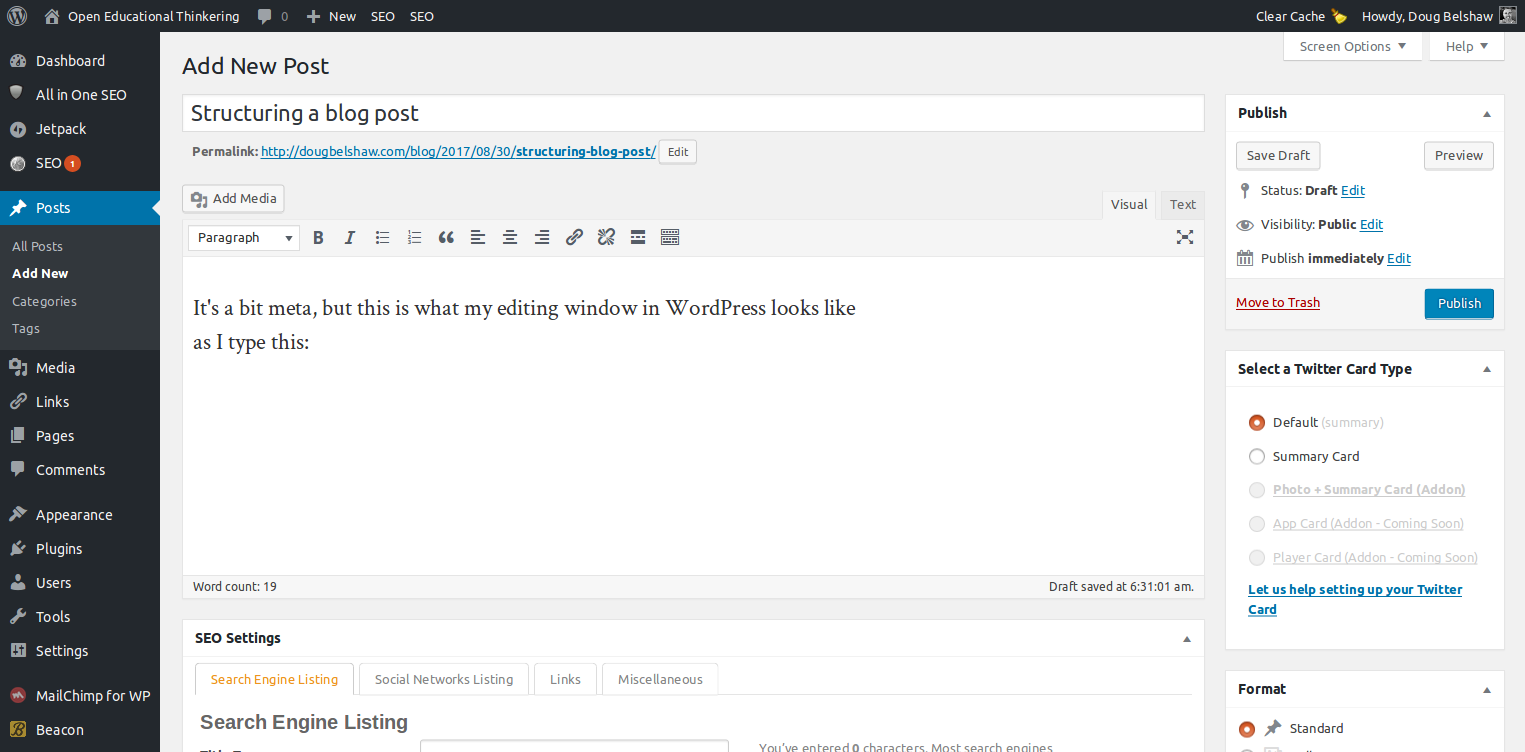Deciding what to write about in your blog post
This is part of a series. In the following, I cover some of the things you should consider as you think about what to discuss in your blog post.
Usually, when people ask me about blogging, they ask me about one of two things. They either wonder where I find time to write, or how I find things to write about.
Where do ideas come from?
I’m a bit like the novelist Henry James in thinking that ideas for writing surround us. They’re in the air, sparked by conversations, things we read, and thoughts we have. Almost always these writing ideas are prompted, which means that if you want to improve the rate of your outputs, the easiest way to do so is to increase the rate of your inputs. Read more. Have more conversations. Spend time walking and thinking.
Ideas come from other ideas, as Steven Johnson notes:
When it comes to the nitty-gritty of writing, however, I came across some fantastic advice shared in a wonderful book by Anne Lamott entitled Bird by bird: some instructions on writing and life. In it, the author, who runs writing classes as well as writing works of fiction and non-fiction, writes:
“E. L. Doctorow once said that “writing a novel is like driving a car at night. You can see only as far as your headlights, but you can make the whole trip that way.” You don’t have to see where you’re going, you don’t have to see your destination or everything you will pass along the way. You just have to see two or three feet ahead of you. This is right up there with the best advice about writing, or life, I have ever heard.”
Just start writing. Many blog posts I’ve started writing have morphed into something completely different. I often start with a title and the subject I want to write about. By the time I’ve finished my first draft, I have to completely change the title because what I’ve written bears no resemblance to what I set out to write. And that’s OK.
There’s nothing new under the sun, so it’s probable that someone’s written a blog post similar to the one you’re planning to put out into the world. That doesn’t matter. The world’s interested in your perspective. What have you noticed? How did that thing turn out when you applied it to your situation? Why did this idea remind you of something else you’ve experienced?
Contributing to the wider conversation
You never know what effect you’re going to have on a reader until you put your thoughts out there. I can remember being encouraged at church when I was younger by hearing that people need to be evangelised to six or seven times before they’re ready to engage. The same is true of brands trying to make a sale. You don’t know where people are on their journey, and you’ll never know (unless they tell you) what effect your writing will have on their life.
Think of your writing as part of a the wider tapestry of the web. You’re providing a thread that other will weave together into a more complex whole. It’s worth noting, to quote Anne Lamott again, that, at least until you’ve got into your blogging groove, your first drafts are likely to be terrible. Lamott suggests recognising and celebrating the fact that no-one will ever see these ‘shitty first drafts’:
“All good writers write [shitty first drafts]. This is how they end up with good second drafts and terrific third drafts. . . I know some very great writers, writers you love who write beautifully and have made a great deal of money, and not one of them sits down routinely feeling wildly enthusiastic and confident. Not one of them writes elegant first drafts.”
The upside of this is that you’ll have an insight into the trials and tribulations that other writers, bloggers, and essayists go through in order to get just the right word or sentence formation to convey their meaning. You’ll be more likely to share and comment upon good writing. In turn, seeking out that quality writing will have an impact on your own.
Finally…
If you’re sitting there with the cursor blinking in front of you or a vast white expanse of emptiness to fill, then tighten the focus. I can’t find the exact quotation, but I think it’s in Bird by bird that Lamott talks about describing a particular scene in as much detail as possible.
While she’s talking about fiction-writing, Lamott’s advice is useful for any kind of writing. Focusing in on a particular aspect of the thing you want to talk about helps get you started, helps get you some of the way towards finishing that ‘shitty first draft’ that you can then build upon.
Again, just get started. If you feel like something’s on the tip of your tongue, literally write gibberish using your pen or keyboard until the words come. The brain is wonderful at self-correcting when it sees something that’s wrong. If what you see in front of you is different from what’s latent inside your mind, often the right words come tumbling out. Try it!
Photo by WOCinTech Chat used under a Creative Commons Attribution license.




